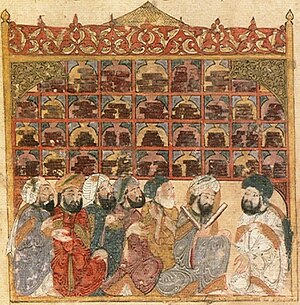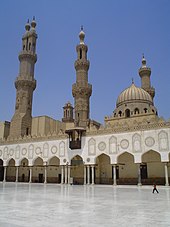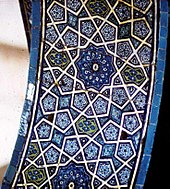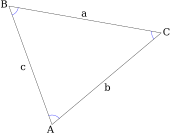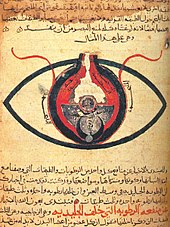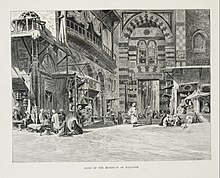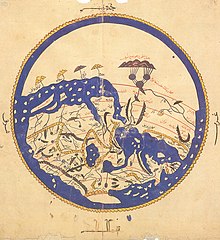Islamic Golden Age
Definition
The Islamic Golden Age is the era in the history of Islam, traditionally dated from the 8th century to the 14th century, during which much of the historically Islamic world was ruled by various caliphates, and science, economic development and cultural works flourished. This period is traditionally understood to have begun during the reign of the Abbasid caliph Harun al-Rashid (786 to 809) with the inauguration of the House of Wisdom in Baghdad, where scholars from various parts of the world with different cultural backgrounds were mandated to gather and translate all of the world's classical knowledge into the Arabic language. This period is traditionally said to have ended with the collapse of the Abbasid caliphate due to Mongol invasionsand the Siege of Baghdad in 1258 AD. A few contemporary scholars place the end of the Islamic Golden Age as late as the end of 15th to 16th centuries.
History of the concepts
The metaphor of a golden age began to be applied in 19th-century literature about Islamic history, in the context of the western aesthetic fashion known as Orientalism. The author of a Handbook for Travelers in Syria and Palestine in 1868 observed that the most beautiful mosques of Damascus were "like Mohammedanism itself, now rapidly decaying" and relics of "the golden age of Islam".
There is no unambiguous definition of the term, and depending on whether it is used with a focus on cultural or on military achievement, it may be taken to refer to rather disparate time spans. Thus, one author would have it extend to the duration of the caliphate, or to "six and a half centuries", while another would have it end after only a few decades of Rashidun conquests, with the death of Umar and the First Fitna.
During the early 20th century, the term was used only occasionally, and often referred to the early military successes of the Rashidun caliphs. It was only in the second half of the 20th century that the term came to be used with any frequency, now mostly referring to the cultural flourishing of science and mathematics under the caliphates during the 9th to 11th centuries (between the establishment of organised scholarship in the House of Wisdom and the beginning of the crusades), but often extended to include part of the late 8th or the 12th to early 13th centuries. Definitions may still vary considerably. Equating the end of the golden age with the end of the caliphates is a convenient cut-off point based on a historical landmark, but it can be argued that Islamic culture had entered a gradual decline much earlier; thus, Khan (2003) identifies the proper golden age as being the two centuries between 750–950, arguing that the beginning loss of territories under Harun al-Rashid worsened after the death of al-Ma'mun in 833, and that the crusades in the 12th century resulted in a further weakening of the Abbasid empire from which it never recovered.
Causes
Religious influence
The various Quranic injunctions and Hadith, which place values on education and emphasize the importance of acquiring knowledge, played a vital role in influencing the Muslims of this age in their search for knowledge and the development of the body of science.
Government sponsorship
The Islamic Empire heavily patronized scholars. The money spent on the Translation Movement for some translations is estimated to be equivalent to about twice the annual research budget of the United Kingdom’s Medical Research Council. The best scholars and notable translators, such as Hunayn ibn Ishaq, had salaries that are estimated to be the equivalent of professional athletes today. The House of Wisdom was a library established in Abbasid-era Baghdad, Iraq by Caliph al-Mansur.
Earlier cultural influence
During this period, the Muslims showed a strong interest in assimilating the scientific knowledge of the civilizations that had been conquered. Many classic works of antiquity that might otherwise have been lost were translated from Greek, Persian, Indian, Chinese, Egyptian, and Phoenician civilizations into Arabic and Persian, and later in turn translated into Turkish, Hebrew, and Latin.
Christians, especially the adherents of the Church of the East (Nestorians), contributed to Islamic civilization during the reign of the Ummayads and the Abbasids by translating works of Greek philosophers and ancient science to Syriac and afterwards to Arabic. They also excelled in many fields, in particular philosophy, science (such as Hunayn ibn Ishaq, Thabit Ibn Qurra, Yusuf Al-Khuri, Al Himsi, Qusta ibn Luqa, Masawaiyh, Patriarch Eutychius, and Jabril ibn Bukhtishu) and theology. For a long period of time the personal physicians of the Abbasid Caliphs were often Assyrian Christians. Among the most prominent Christian families to serve as physicians to the caliphs were the Bukhtishu dynasty.
Throughout the 4th to 7th centuries, Christian scholarly work in the Greek and Syriac languages was either newly translated or had been preserved since the Hellenistic period. Among the prominent centers of learning and transmission of classical wisdom were Christian colleges such as the School of Nisibis and the School of Edessa, the pagan University of Harran and the renowned hospital and medical academy of Jundishapur, which was the intellectual, theological and scientific center of the Church of the East. The House of Wisdom was founded in Baghdad in 825, modelled after the Academy of Gondishapur. It was led by Christian physician Hunayn ibn Ishaq, with the support of Byzantine medicine. Many of the most important philosophical and scientific works of the ancient world were translated, including the work of Galen, Hippocrates, Plato, Aristotle, Ptolemy and Archimedes. Many scholars of the House of Wisdom were of Christian background.
New technology
With a new and easier writing system, and the introduction of paper, information was democratized to the extent that, for probably the first time in history, it became possible to make a living from simply writing and selling books. The use of paper spread from China into Muslim regions in the eighth century, arriving in Al-Andalus on the Iberian peninsula, present-day Spain in the 10th century. It was easier to manufacture than parchment, less likely to crack than papyrus, and could absorb ink, making it difficult to erase and ideal for keeping records. Islamic paper makers devised assembly-line methods of hand-copying manuscripts to turn out editions far larger than any available in Europe for centuries. It was from these countries that the rest of the world learned to make paper from linen.
Major contributors
Among the various countries and cultures conquered through successive Islamic conquests, a remarkable number of scientists originated from Persia, who contributed immensely to the scientific flourishing of the Islamic Golden Age. According to Bernard Lewis:"Culturally, politically, and most remarkable of all even religiously, the Persian contribution to this new Islamic civilization is of immense importance. The work of Iranians can be seen in every field of cultural endeavor, including Arabic poetry, to which poets of Iranian origin composing their poems in Arabic made a very significant contribution."
Science, medicine, philosophy and technology in the newly Islamized Iranian society was influenced by and based on the scientific model of the major pre-Islamic Iranian universities in the Sassanian Empire. During this period hundreds of scholars and scientists vastly contributed to technology, science and medicine, later influencing the rise of European science during the Renaissance.
Education
The centrality of scripture and its study in the Islamic tradition helped to make education a central pillar of the religion in virtually all times and places in the history of Islam. The importance of learning in the Islamic tradition is reflected in a number of hadiths attributed to Muhammad, including one that instructs the faithful to "seek knowledge, even in China". This injunction was seen apply particularly to scholars, but also to some extent to the wider Muslim public, as exemplified by the dictum of Al-Zarnuji, "learning is prescribed for us all". While it is impossible to calculate literacy rates in pre-modern Islamic societies, it is almost certain that they were relatively high, at least in comparison to their European counterparts.
Education would begin at a young age with study of Arabic and the Quran, either at home or in a primary school, which was often attached to a mosque. Some students would then proceed to training in tafsir (Quranic exegesis) and fiqh (Islamic jurisprudence), which was seen as particularly important. Education focused on memorization, but also trained the more advanced students to participate as readers and writers in the tradition of commentary on the studied texts. It also involved a process of socialization of aspiring scholars, who came from virtually all social backgrounds, into the ranks of the ulema.
For the first few centuries of Islam, educational settings were entirely informal, but beginning in the 11th and 12th centuries, the ruling elites began to establish institutions of higher religious learning known as madrasas in an effort to secure support and cooperation of the ulema. Madrasas soon multiplied throughout the Islamic world, which helped to spread Islamic learning beyond urban centers and to unite diverse Islamic communities in a shared cultural project. Nonetheless, instruction remained focused on individual relationships between students and their teacher. The formal attestation of educational attainment, ijaza, was granted by a particular scholar rather than the institution, and it placed its holder within a genealogy of scholars, which was the only recognized hierarchy in the educational system. While formal studies in madrasas were open only to men, women of prominent urban families were commonly educated in private settings and many of them received and later issued ijazas in hadith studies, calligraphy and poetry recitation. Working women learned religious texts and practical skills primarily from each other, though they also received some instruction together with men in mosques and private homes.
Muslims distinguished disciplines inherited from pre-Islamic civilizations, such as philosophy and medicine, which they called "sciences of the ancients" or "rational sciences", from Islamic religious sciences. Sciences of the former type flourished for several centuries, and their transmission formed part of the educational framework in classical and medieval Islam. In some cases, they were supported by institutions such as the House of Wisdom in Baghdad, but more often they were transmitted informally from teacher to student.
The University of Al Karaouine, founded in 859 AD, is arguably the world's oldest degree-granting university. The Al-Azhar University was another early university. Islamic "universities" of the Middle Ages were in fact madrasas, centers for the study of religious texts and law. Only after the Arabs came in contact with the institutions of higher learning of the Christian Greek Roman Empire during their conquests did the madrasas begin to teach other subjects as well - but the only degree granted remained that of expert in religious law: "There was no other 'doctorate' in any other field, no license to teach a field except that of the religious law". The madrasa is one of the relics of the Fatimid caliphate. The Fatimids traced their descent to Muhammad's daughter Fatimah and named the institution using a variant of her honorific title Al-Zahra (the brilliant). Organized instruction in the Al-Azhar Mosque began in 978.
Law
Juristic thought gradually developed in study circles, where independent scholars met to learn from a local master and discuss religious topics. At first, these circles were fluid in their membership, but with time distinct regional legal schools crystallized around shared sets of methodological principles. As the boundaries of the schools became clearly delineated, the authority of their doctrinal tenets came to be vested in a master jurist from earlier times, who was henceforth identified as the school's founder. In the course of the first three centuries of Islam, all legal schools came to accept the broad outlines of classical legal theory, according to which Islamic law had to be firmly rooted in the Quran and hadith.
The classical theory of Islamic jurisprudence elaborates how scriptures should be interpreted from the standpoint of linguistics and rhetoric. It also comprises methods for establishing authenticity of hadith and for determining when the legal force of a scriptural passage is abrogated by a passage revealed at a later date. In addition to the Quran and sunnah, the classical theory of Sunni fiqh recognizes two other sources of law: juristic consensus (ijmaʿ) and analogical reasoning (qiyas). It therefore studies the application and limits of analogy, as well as the value and limits of consensus, along with other methodological principles, some of which are accepted by only certain legal schools. This interpretive apparatus is brought together under the rubric of ijtihad, which refers to a jurist's exertion in an attempt to arrive at a ruling on a particular question. The theory of Twelver Shia jurisprudence parallels that of Sunni schools with some differences, such as recognition of reason (ʿaql) as a source of law in place of qiyas and extension of the notion of sunnah to include traditions of the imams.
The body of substantive Islamic law was created by independent jurists (muftis). Their legal opinions (fatwas) were taken into account by ruler-appointed judges who presided over qāḍī's courts, and by maẓālimcourts, which were controlled by the ruler's council and administered criminal law.
Theology
Classical Islamic theology emerged from an early doctrinal controversy which pitted the ahl al-hadith movement, led by Ahmad ibn Hanbal, who considered the Quran and authentic hadith to be the only acceptable authority in matters of faith, against Mu'tazilites and other theological currents, who developed theological doctrines using rationalistic methods. In 833 the caliph al-Ma'mun tried to impose Mu'tazilite theology on all religious scholars and instituted an inquisition (mihna), but the attempts to impose a caliphal writ in matters of religious orthodoxy ultimately failed. This controversy persisted until al-Ash'ari (874-936) found a middle ground between Mu'tazilite rationalism and Hanbalite literalism, using the rationalistic methods championed by Mu'tazilites to defend most substantive tenets maintained by ahl al-hadith. A rival compromise between rationalism and literalism emerged from the work of al-Maturidi (d. c. 944), and, although a minority of scholars remained faithful to the early ahl al-hadith creed, Ash'ari and Maturidi theology came to dominate Sunni Islam from the 10th century on.
Philosophy
Ibn Sina (Avicenna) and Ibn Rushd (Averroes) played a major role in saving the works of Aristotle, whose ideas came to dominate the non-religious thought of the Christianand Muslim worlds. According to the Stanford Encyclopedia of Philosophy, translation of philosophical texts from Arabic to Latin in Western Europe "led to the transformation of almost all philosophical disciplines in the medieval Latin world". The influence of Islamic philosophers in Europe was particularly strong in natural philosophy, psychology and metaphysics, though it also influenced the study of logic and ethics.
Metaphysics
Avicenna argued his "Floating man" thought experiment concerning self-awareness, in which a man prevented of sense experience by being blindfolded and free falling would still be aware of his existence.
Epistemology
In epistemology, Ibn Tufail wrote the novel Hayy ibn Yaqdhan and in response Ibn al-Nafis wrote the novel Theologus Autodidactus. Both were concerning autodidacticismas illuminated through the life of a feral child spontaneously generated in a cave on a desert island.
Mathematics
Algebra
Muḥammad ibn Mūsā al-Khwārizmī played a significant role in the development of algebra, arithmetic and Hindu-Arabic numerals.
Geometry
Islamic art makes use of geometric patterns and symmetries in many of its art forms, notably in girih tilings. These are formed using a set of five tile shapes, namely a regular decagon, an elongated hexagon, a bow tie, a rhombus, and a regular pentagon. All the sides of these tiles have the same length; and all their angles are multiples of 36° (π/5 radians), offering fivefold and tenfold symmetries. The tiles are decorated with strapwork lines (girih), generally more visible than the tile boundaries. In 2007, the physicists Peter Lu and Paul Steinhardt argued that girih from the 15th century resembled quasicrystalline Penrose tilings. Elaborate geometric zellige tilework is a distinctive element in Moroccan architecture. Muqarnas vaults are three-dimensional but were designed in two dimensions with drawings of geometrical cells.
Trigonometry
Ibn Muʿādh al-Jayyānī is one of several Islamic mathematicians to whom the law of sines is attributed; he wrote his The Book of Unknown Arcs of a Sphere in the 11th century. This formula relates the lengths of the sides of any triangle, rather than only right triangles, to the sines of its angles. According to the law,
where a, b, and c are the lengths of the sides of a triangle, and A, B, and C are the opposite angles (see figure).
Calculus
Alhazen discovered the sum formula for the fourth power, using a method that could be generally used to determine the sum for any integral power. He used this to find the volume of a paraboloid. He could find the integral formula for any polynomial without having developed a general formula.
Natural sciences
Scientific method
Ibn al-Haytham (Alhazen) was a significant figure in the history of scientific method, particularly in his approach to experimentation, and has been described as the "world's first true scientist".
Avicenna made rules for testing the effectiveness of drugs, including that the effect produced by the experimental drug should be seen constantly or after many repetitions, to be counted. The physician Rhazes was an early proponent of experimental medicine and recommended using control for clinical research. He said: "If you want to study the effect of bloodletting on a condition, divide the patients into two groups, perform bloodletting only on one group, watch both, and compare the results."
Astronomy
In about 964 AD, the Persian astronomer Abd al-Rahman al-Sufi, writing in his Book of Fixed Stars, described a "nebulous spot" in the Andromeda constellation, the first definitive reference to what we now know is the Andromeda Galaxy, the nearest spiral galaxy to our galaxy. Nasir al-Din al-Tusi invented a geometrical technique called a Tusi-couple, which generates linear motion from the sum of two circular motions to replace Ptolemy's problematic equant. The Tusi couple was later employed in Ibn al-Shatir's geocentric model and Nicolaus Copernicus' heliocentric Copernican model although it is not known who the intermediary is or if Copernicus rediscovered the technique independently.
Physics
Alhazen played a role in the development of optics. One of the prevailing theories of vision in his time and place was the emission theory supported by Euclid and Ptolemy, where sight worked by the eye emitting rays of light, and the other was the Aristotelean theory that sight worked when the essence of objects flows into the eyes. Alhazen correctly argued that vision occurred when light, traveling in straight lines, reflects off an object into the eyes. Al-Biruni wrote of his insights into light, stating that its velocity must be immense when compared to the speed of sound.
Chemistry
Al-Kindi warned against alchemists attempting the transmutation of simple, base metals into precious ones like gold in the ninth century.
Geodesy
Al-Biruni (973-1048) estimated the radius of the earth as 6339.6 km (modern value is c. 6,371 km), the best estimate at that time.
Biology
In the cardiovascular system, Ibn al-Nafis in his Commentary on Anatomy in Avicenna's Canon was the first known scholar to contradict the contention of the Galen School that blood could pass between the ventricles in the heart through the cardiac inter-ventricular septum that separates them, saying that there is no passage between the ventricles at this point. Instead, he correctly argued that all the blood that reached the left ventricle did so after passing through the lung. He also stated that there must be small communications, or pores, between the pulmonary artery and pulmonary vein, a prediction that preceded the discovery of the pulmonary capillaries of Marcello Malpighi by 400 years. The Commentary was rediscovered in the twentieth century in the Prussian State Library in Berlin; whether its view of the pulmonary circulation influenced scientists such as Michael Servetus is unclear.
In the nervous system, Rhazes stated that nerves had motor or sensory functions, describing 7 cranial and 31 spinal cord nerves. He assigned a numerical order to the cranial nerves from the optic to the hypoglossal nerves. He classified the spinal nerves into 8 cervical, 12 thoracic, 5 lumbar, 3 sacral, and 3 coccygeal nerves. He used this to link clinical signs of injury to the corresponding location of lesions in the nervous system.
Modern commentators have likened medieval accounts of the "struggle for existence" in the animal kingdom to the framework of the theory of evolution. Thus, in his survey of the history of the ideas which led to the theory of natural selection, Conway Zirkle noted that al-Jahiz was one of those who discussed a "struggle for existence", in his Kitāb al-Hayawān (Book of Animals), written in the 9th century. In the 13th century, Nasir al-Din al-Tusi believed that humans were derived from advanced animals, saying, "Such humans [probably anthropoid apes] live in the Western Sudan and other distant corners of the world. They are close to animals by their habits, deeds and behavior." In 1377, Ibn Khaldun in his Muqaddimah stated, "The animal kingdom was developed, its species multiplied, and in the gradual process of Creation, it ended in man and arising from the world of the monkeys."
Engineering
The Banū Mūsā brothers, in their Book of Ingenious Devices, describe an automatic flute player which may have been the first programmable machine. The flute sounds were produced through hot steam and the user could adjust the device to various patterns so that they could get various sounds from it.
Social sciences
Ibn Khaldun is regarded to be among the founding fathers of modern sociology, historiography, demography, and economics.
Healthcare
Hospitals
The earliest known Islamic hospital was built in 805 in Baghdad by order of Harun Al-Rashid, and the most important of Baghdad's hospitals was established in 982 by the Buyid ruler 'Adud al-Dawla. The best documented early Islamic hospitals are the great Syro-Egyptian establishments of the 12th and 13th centuries. By the tenth century, Baghdad had five more hospitals, while Damascus had six hospitals by the 15th century and Córdoba alone had 50 major hospitals, many exclusively for the military.
The typical hospital was divided into departments such as systemic diseases, surgery, and orthopedics, with larger hospitals having more diverse specialties. "Systemic diseases" was the rough equivalent of today's internal medicine and was further divided into sections such as fever, infections and digestive issues. Every department had an officer-in-charge, a presiding officer and a supervising specialist. The hospitals also had lecture theaters and libraries. Hospitals staff included sanitary inspectors, who regulated cleanliness, and accountants and other administrative staff. The hospitals were typically run by a three-man board comprising a non-medical administrator, the chief pharmacist, called the shaykh saydalani, who was equal in rank to the chief physician, who served as mutwalli (dean). Medical facilities traditionally closed each night, but by the 10th century laws were passed to keep hospitals open 24 hours a day.
For less serious cases, physicians staffed outpatient clinics. Cities also had first aid centers staffed by physicians for emergencies that were often located in busy public places, such as big gatherings for Friday prayers. The region also had mobile units staffed by doctors and pharmacists who were supposed to meet the need of remote communities. Baghdad was also known to have a separate hospital for convicts since the early 10th century after the vizier ‘Ali ibn Isa ibn Jarah ibn Thabit wrote to Baghdad’s chief medical officer that "prisons must have their own doctors who should examine them every day". The first hospital built in Egypt, in Cairo's Southwestern quarter, was the first documented facility to care for mental illnesses. In Aleppo's Arghun Hospital, care for mental illness included abundant light, fresh air, running water and music.
Medical students would accompany physicians and participate in patient care. Hospitals in this era were the first to require medical diplomas to license doctors. The licensing test was administered by the region's government appointed chief medical officer. The test had two steps; the first was to write a treatise, on the subject the candidate wished to obtain a certificate, of original research or commentary of existing texts, which they were encouraged to scrutinize for errors. The second step was to answer questions in an interview with the chief medical officer. Physicians worked fixed hours and medical staff salaries were fixed by law. For regulating the quality of care and arbitrating cases, it is related that if a patient dies, their family presents the doctor's prescriptions to the chief physician who would judge if the death was natural or if it was by negligence, in which case the family would be entitled to compensation from the doctor. The hospitals had male and female quarters while some hospitals only saw men and other hospitals, staffed by women physicians, only saw women. While women physicians practiced medicine, many largely focused on obstetrics.
Hospitals were forbidden by law to turn away patients who were unable to pay. Eventually, charitable foundations called waqfs were formed to support hospitals, as well as schools. Part of the state budget also went towards maintaining hospitals. While the services of the hospital were free for all citizens and patients were sometimes given a small stipend to support recovery upon discharge, individual physicians occasionally charged fees. In a notable endowment, a 13th-century governor of Egypt Al-Mansur Qalawun ordained a foundation for the Qalawun hospital that would contain a mosque and a chapel, separate wards for different diseases, a library for doctors and a pharmacy and the hospital is used today for ophthalmology. The Qalawun hospital was based in a former Fatimid palace which had accommodation for 8,000 people - "it served 4,000 patients daily." The waqf stated,
Pharmacies
By the ninth century, there was a rapid expansion of private pharmacies in many Muslim cities. Initially, these were unregulated and managed by personnel of inconsistent quality. Decrees by Caliphs Al-Ma'mun and Al-Mu'tasim required examinations to license pharmacists and pharmacy students were trained in a combination of classroom exercises coupled with day-to-day practical experiences with drugs. To avoid conflicts of interest, doctors were banned from owning or sharing ownership in a pharmacy. Pharmacies were periodically inspected by government inspectors called muhtasib, who checked to see that the medicines were mixed properly, not diluted and kept in clean jars. Violators were fined or beaten.
Medicine
The theory of Humorism was largely dominant during this time. Arab physician Ibn Zuhr provided proof that scabies is caused by the itch mite and that it can be cured by removing the parasite without the need for purging, bleeding or other treatments called for by humorism, making a break with the humorism of Galen and Ibn Sina. Rhazes differentiated through careful observation the two diseases smallpox and measles, which were previously lumped together as a single disease that caused rashes. This was based on location and the time of the appearance of the symptoms and he also scaled the degree of severity and prognosis of infections according to the color and location of rashes. Al-Zahrawi was the first physician to describe an ectopic pregnancy, and the first physician to identify the hereditary nature of haemophilia.
On hygienic practices, Rhazes, who was once asked to choose the site for a new hospital in Baghdad, suspended pieces of meat at various points around the city, and recommended building the hospital at the location where the meat putrefied most slowly.
For Islamic scholars, Indian and Greek physicians and medical researchers Sushruta, Galen, Mankah, Atreya, Hippocrates, Charaka, and Agnivesa were pre-eminent authorities. In order to make the Indian and Greek tradition more accessible, understandable, and teachable, Islamic scholars ordered and made more systematic the vast Indian and Greco-Roman medical knowledge by writing encyclopedias and summaries. Sometimes, past scholars were criticized, like Rhazes who criticized and refuted Galen's revered theories, most notably, the Theory of Humors and was thus accused of ignorance. It was through 12th-century Arabic translations that medieval Europe rediscovered Hellenic medicine, including the works of Galen and Hippocrates, and discovered ancient Indian medicine, including the works of Sushrutaand Charaka. Works such as Avicenna's The Canon of Medicine were translated into Latin and disseminated throughout Europe. During the 15th and 16th centuries alone, The Canon of Medicine was published more than thirty-five times. It was used as a standard medical textbook through the 18th century in Europe.
Surgery
Al-Zahrawi was a tenth century Arab physician. He is sometimes referred to as the "Father of surgery". He describes what is thought to be the first attempt at reduction mammaplasty for the management of gynaecomastia and the first mastectomy to treat breast cancer. He is credited with the performance of the first thyroidectomy.
Commerce and travel
Apart from the Nile, Tigris, and Euphrates, navigable rivers were uncommon in the Middle East, so transport by sea was very important. Navigational sciences were highly developed, making use of a rudimentary sextant (known as a kamal). When combined with detailed maps of the period, sailors were able to sail across oceans rather than skirt along the coast. Muslim sailors were also responsible for reintroducing large, three-masted merchant vessels to the Mediterranean. The name caravel may derive from an earlier Arab boat known as the qārib.
Many Muslims went to China to trade, and these Muslims began to have a great economic influence on the country. Muslims virtually dominated the import/export industry by the time of the Sung dynasty (960-1279).
Arts and culture
Literature and poetry
The 13th century Persian poet Rumi wrote some of the finest Persian poetry and is still one of the best selling poets in America.
Art
Manuscript illumination was an important art, and Persian miniature painting flourished in the Persianate world. Calligraphy, an essential aspect of written Arabic, developed in manuscripts and architectural decoration.
Architecture
The Great Mosque of Kairouan (in Tunisia), the ancestor of all the mosques in the western Islamic world, is one of the best preserved and most significant examples of early great mosques. Founded in 670, it dates in its present form largely from the 9th century. The Great Mosque of Kairouan is constituted of a three-tiered square minaret, a large courtyard surrounded by colonnaded porticos, and a huge hypostyle prayer hall covered on its axis by two cupolas.
The Great Mosque of Samarra in Iraq was completed in 847. It combined the hypostyle architecture of rows of columns supporting a flat base, above which a huge spiralling minaret was constructed.
The beginning of construction of the Great Mosque at Cordoba in 785 marked the beginning of Islamic architecture in Spain and Northern Africa. The mosque is noted for its striking interior arches. Moorish architecture reached its peak with the construction of the Alhambra, the magnificent palace/fortress of Granada, with its open and breezy interior spaces adorned in red, blue, and gold. The walls are decorated with stylized foliage motifs, Arabic inscriptions, and arabesque design work, with walls covered in geometrically patterned glazed tiles.
Many traces of Fatimid architecture exist in Cairo today, the most defining examples include the Al Azhar University and the Al Hakim mosque.
Decline
Invasions
In 1206, Genghis Khan established a powerful dynasty among the Mongols of central Asia. During the 13th century, this Mongol Empire conquered most of the Eurasian land mass, including China in the east and much of the old Islamic caliphate (as well as Kievan Rus') in the west. The destruction of Baghdad and the House of Wisdomby Hulagu Khan in 1258 has been seen by some as the end of the Islamic Golden Age.
The Ottoman conquest of the Arabic-speaking Middle East in 1516-17 placed the traditional heart of the Islamic world under Ottoman Turkish control. The rational sciences continued to flourish in the Middle East during the Ottoman period.
Economics
To account for the decline of Islamic science, it has been argued that the Sunni Revival in the 11th and 12th centuries produced a series of institutional changes that decreased the relative payoff to producing scientific works. With the spread of madrasas and the greater influence of religious leaders, it became more lucrative to produce religious knowledge. This is easily refutable, as the scholars of the golden age were experts in both religious and secular fields, with many of the Islamic schools of thoughts having been established during the golden age itself.
Ahmad Y. al-Hassan has rejected the thesis that lack of creative thinking was a cause, arguing that science was always kept separate from religious argument; he instead analyzes the decline in terms of economic and political factors, drawing on the work of the 14th-century writer Ibn Khaldun. Al-Hassan extended the golden age up to the 16th century, noting that scientific activity continued to flourish up until then. Several other contemporary scholars have also extended it to around the 16th to 17th centuries, and analysed the decline in terms of political and economic factors. More recent research has challenged the notion that it underwent decline even at that time, citing a revival of works produced on rational scientific topics during the seventeenth century.
Culture
Economic historian Joel Mokyr has argued that Islamic philosopher al-Ghazali (1058–1111) "was a key figure in the decline in Islamic science", as his works contributed to rising mysticism and occasionalism in the Islamic world. Against this view, Saliba (2007) has given a number of examples especially of astronomical research flourishing after the time of al-Ghazali.
Retrieved from: Islamic_Golden_AgeText is available under the Creative Commons Attribution-ShareAlike License
